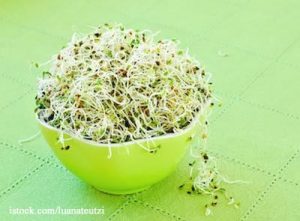An E. coli O157:NM outbreak linked to recalled Jack and the Green Sprouts raw alfalfa sprouts and alfalfa onion sprouts has sickened seven people in Minnesota and two people in Wisconsin. Sprouts are a risky food that have been linked to at least 30 outbreaks in the past 20 years. In addition, many recalls of this product have been issued.
 The FDA has issued two about growing raw sprouts. In July 1999, the FDA issued an advisory to the public called “Consumers Advices of Risks Associated with Raw Sprouts,” along with two guidance documents for sprout growers to try to deal with the problem.
The FDA has issued two about growing raw sprouts. In July 1999, the FDA issued an advisory to the public called “Consumers Advices of Risks Associated with Raw Sprouts,” along with two guidance documents for sprout growers to try to deal with the problem.
Sprouts include alfalfa, clover, sunflower, broccoli, mustard, radish, garlic, dill and pumpkin as well as mung, kidney, pinto, navy, soy beans and wheat berries (wheat grass). The most common types linked to outbreaks and recalls are alfalfa sprouts, clover sprouts, and mung bean sprouts.
The FDA states that “if pathogens are present, they can increase exponentially by 2-6 logs in the first several days of sprouting.” That means that sprouts grow by 2,000 to 6,000 times during the sprouting process. Furthermore, E. coli O157:H7 can multiply 103 to 105, or from 1,000 to 100,000 times during germination and sprouting. Ten E. coli bacteria in the seed or bean can become 10,000 or 1,000,000 E. coli bacteria in the sprouts very quickly. And it only takes 10 E. coli bacteria to make you sick. Beans and seeds are usually sprouted from three to ten days, which is plenty of time for bacteria to grow to astounding levels in the product.
The FDA continues, “There is no step in the production of raw sprouts such as cooking or pasteurization to reduce or eliminate pathogens before consumption. In addition, many sprout producers are unaware that raw sprouts have been the vehicle for foodborne illness.”
Contamination can happen in the field, during harvest, in transport, and while the seeds are germinating. The FDA states that while seeds are easier to sanitize than sprouts, seeds are more resistant to treatment. And the bacteria can actually be encapsulated inside the seeds, which means that cleaning the seeds will have no effect whatsoever.
In addition, the roots of the sprout can take bacteria up into the sprout tissue while they are growing, which makes any type of cleaning, other than irradiation, completely ineffective. The only way to prevent these outbreaks is to keep contaminated sprouts from being sold, which is easier said than done.
And there are more problems. Pathogens can survive for weeks or months on seeds when they are in dry storage. Bacteria can form biofilms while they grow that protect pathogens such as E. coli from sanitizers and disinfectants. The growing medium, as we have said before, is the perfect condition for bacterial growth. And many seeds are not identified as seed for sprouting, but are considered a commodity to plant and grow more fields of that crop. The seeds, therefore, may be mishandled or stored under conditions that are not suitable for a raw ready-to-eat food item.
So what can you do? If you or a member of your family are in a high risk group, which includes children, the elderly, those with compromised immune systems, pregnant women, or people with chronic health problems, do not serve raw sprouts at all. Ever. The FDA states “there is no single treatment so far that has been shown to completely eliminate pathogens on seeds or sprouts that case foodborne illness without affecting germination or yield.”
If you still want to eat sprouts, cook them before you eat them. It’s true that one of the main characteristics of sprouts that people enjoy is the crunch they provide, and that crunch is destroyed by cooking. But if you want to avoid getting sick, avoiding or cooking sprouts is the only way to go.
If you did eat any of the recalled raw sprouts and have experienced the symptoms of an E. coli infection, see your doctor. This is a serious illness and you should have medical care while you are sick.
The symptoms of an E. coli infection include severe abdominal cramps, diarrhea that may be bloody or watery, a mild fever, and vomiting. Two people have been hospitalized in this outbreak, which means they are very sick. And if E. coli is improperly treated with antibiotics, hemolytic uremic syndrome (HUS), a potentially deadly complication, can develop. The symptoms of HUS include little or no urine output, pale skin, lethargy, easy bruising, a skin rash, and bleeding from the nose or mouth. Anyone experiencing these symptoms should be taken to a doctor immediately.




